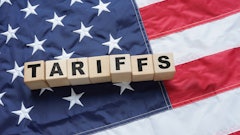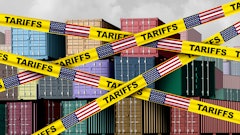New York — March 21, 2008 — U.S. importers are talking about "10+2". No, it's not 12. It's another security initiative launched by the U.S. government to mitigate the risk of terrorism occurring on U.S. soil.
Joining the ranks of other alphabet soup security programs, "10+2" is a tactical program requiring 10 data elements from the importer and 2 data elements from the carrier (hence "10+2") be electronically filed 24 hours prior to loading cargo onto a shipping vessel ultimately bound for the United States.
The overarching goal of the program is to target high-risk cargo by identifying actual cargo movements, improve the accuracy of cargo descriptions and flag low-risk cargo earlier in the supply chain, thereby speeding its movement.
The "10+2" program is ruffling the feathers of the global trade community. It's estimated that this program will cost importers $390 million to $690 million annually due to filing fees instituted by the government and surcharges levied by cargo agents for generating the required information. In addition, importers may have problems gathering the information in advance, thereby causing global cargo departure delays and disrupting timely shipments around the world.
Background
In response to the terrorist events of 2001, the U.S. government enacted the 2006 SAFE Port Act (Security and Accountability for Every Port Act) which aims to increase the security of U.S. ports of entry. A key component of SAFE is the Secure Freight Initiative, which is a comprehensive model for global supply chain security and which complements the use of scanning technology and optical character recognition systems in foreign ports to inspect cargo bound for the United States.
The Secure Freight Initiative is designed to help reduce the risk of terrorism by leveraging trade data, trade partnerships, host country governments and the latest technology to validate the security of goods in maritime shipping containers. Via a more detailed Security Filing, or what is being called "10+2", U.S. Customs and Border Protection (CBP) aims to:
- target high-risk cargo through the identification of actual cargo movements;
- improve the accuracy of cargo descriptions; and,
- speed lawful international trade by recognizing low-risk shipments much earlier in the supply chain.
Currently, CBP relies primarily on carrier manifest information to perform advance targeting prior to vessel loading. The Security Filing component of the Secure Freight Initiative will involve the electronic filing of additional data elements by both importers and carriers for shipments loaded on a vessel bound for a U.S. port.
When fully implemented, the importer will be required to submit 10 data elements through an Import Security Filing 24 hours prior to loading shipments on board the vessel. These elements are:
1. Manufacturer or supplier name and address
2. Seller name and address
3. Buyer name and address
4. Ship to name and address (place where the seal is broken and container is unloaded)
5. Container stuffing locations (name and address of the physical location where the goods were stuffed into the container)
6. Consolidator (stuffer) name and address
7. Importer of record number or Foreign Trade Zone (FTZ) applicant identification number
8. Consignee number
9. Country of origin
10. Commodity HTSUS number at the 6 to 10 digit level
The importer's carrier also will be required to provide 2 additional data elements:
1. Vessel stowage plans
2. Container status messages detailing container movement and status changes (e.g., empty or full).
In addition, there are some special rules for reporting these data elements that must be followed by both the importer and carrier:
- Master Bill of Lading (BOM) must be reported in addition to the above 12 items;
- Data elements must be reported by the tariff number at the lowest bill of lading level;
- Manufacturer (or supplier) name and address, country of origin and commodity HTSUS (harmonized tariff) number must be linked to one another at the line item level.
Details on the format for reporting this information are still pending, but importers should expect implementation of these requirements to roll in phases over the next 12 months.
Impact to the U.S. Importer
Most of the 10 data elements required to be reported prior to shipment are already being provided to Customs for clearance and entry into the United States via the CBP Form 7501. As it has traditionally been the importer's responsibility to ensure the accuracy of these elements, there has been little effort to coordinate this detail between an importer's suppliers, forwarders and carriers.
The potential impact or change to an importer's international supply chain will be:
- Anticipated transactional costs — CBP estimates incremental supply chain costs of $24-$38 per import transaction and that filing costs will average $10-$50 per transaction.
- Potential liquidated damages — Importers could be charged fines equal to the value of the shipment if they fail to file. Importers also face potential charges of $5,000 per transaction for inaccurate or missing data.
- Supply chain delays — Anticipate an increased volume of airfreight due to delays in shipment of containerized cargo and failure to meet customer delivery dates due to delays in shipment.
- Need for improved collaboration with suppliers — Suppliers, freight forwarders and carriers will need to develop, document and implement better procedures to handle the additional filing requirements. Importers now will be required to manage supplier exports for compliance to ensure the accuracy of the data being filed and transmitted via the Import Security Filing. Shipment pre-alerts or pre-advice will no longer be optional. Bill of Lading detail must be obtained by the importer or its agent prior to container arrival at the foreign port.
- More stringent product classification — Identify and implement a procedure for advance determination of the commodity's HTSUS classification. The main objective should be consistency down to the six-digit level for export formalities, various filings for entry including "10+2", Automated Manifest System (AMS), free trade agreements, OGA (other government agencies) and Advanced Trade Data Initiative (ATDI). More stringent product classification will force a change in process for many importers as they will no longer be able to declare a single HTSUS at origin and no longer be able to group parts under an "other, other" classification.
- Adjustment to internal systems — Implement or improve upon procedures for complete and accurate country of origin determination with an emphasis on proper reporting of origin of manufacture. This may require revisions to enterprise resource planning (ERP) systems that default on purchase orders and shipping documents for "place of shipment" as origin.
- Additional reporting requirements — Document and implement a procedure to accommodate additional reporting requirements associated with Carnet shipments and shipments purchased under the INCOTERM DDP, or Deliver Duty Paid. These transactions did not previously require an electronic submission of data or classification of a product by the importer.
- Potential revisions to customs bond — Revisions to an Importer's Customs Bond may result from failure to timely or accurately file the "10+2" information and pay liquidated damages.
Recommendations
The "10+2" program will have cascading impacts to global trade. U.S. Importers and any organization exporting to the United States should heed the following advice:
- Stay current with the "10+2" initiative by visiting CBP's Web site at http://www.cbp.gov/xp/cgov/import/carriers/security_filing/
- Analyze your current processes and procedures to ensure that you are prepared to handle the additional filing requirements of "10+2".
- Focus on how "10+2" affects your supply chain in terms of costs and sourcing. Do changes need to be made to your current supply chain practices? Will new sourcing strategies need to be implemented? Will contracts or service level agreements need to be revised with your forwarders, brokers or carriers?
- If the filing requirements of "10+2" seem too cumbersome to manage, consider outsourcing to a trade expert.















